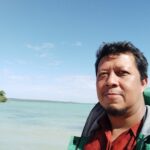
Boedi Sardjana Julianto
Food Entrepreneur
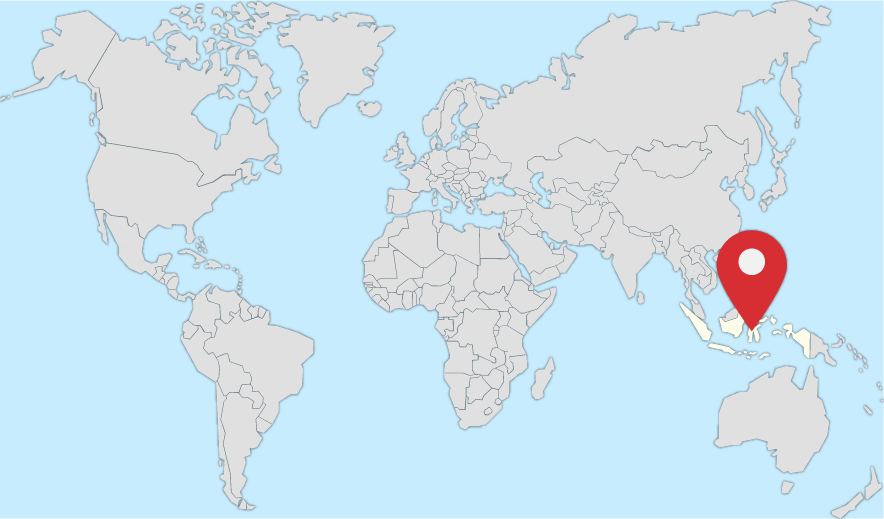
South Sulawesi, Indonesia
Seaweed For Humanity begins with the journey of a seaweed boy from Nova Scotia, Canada, to Indonesia after traveling to Hawaii, Japan, Korea, China, India, Tanzania, Philippines, and Malaysia. After graduating as a marine biologist, the seaweed boy worked for various global seaweed processing companies since 1965. The boy’s name is Dr. Iain Charles Neish, and he was appointed president of the International Seaweed Association from 2010 to 2013.
Dr. Iain Cahrles Neish has dreamed of growing seaweed and living in a tropical country since 1974. It’s not just for his prosperity; seaweed has high value for humanity. Seaweed creates job opportunities and sources of income for vulnerable coastal communities, especially women. Most women don’t have access to and control of the coastal natural resources, nor do they have access to finance, information, or technology for developing and scaling up the seaweed business.
Most women work on binding or tying the seaweed seedling on the nylon lines. They get paid IDR 2,500 to 5,000 per line in South Sulawesi and Nusa Tenggara Timur, Indonesia. We hope to answer the question: how do we support the vulnerable coastal community and women with seaweed aquaculture? The seaweed for humanity will share the story, which covers the opportunity and challenges of women’s roles and responsibilities in the seaweed value chain and industry of South Sulawesi, Bali, and Nusa Tenggara Timur (NTT).
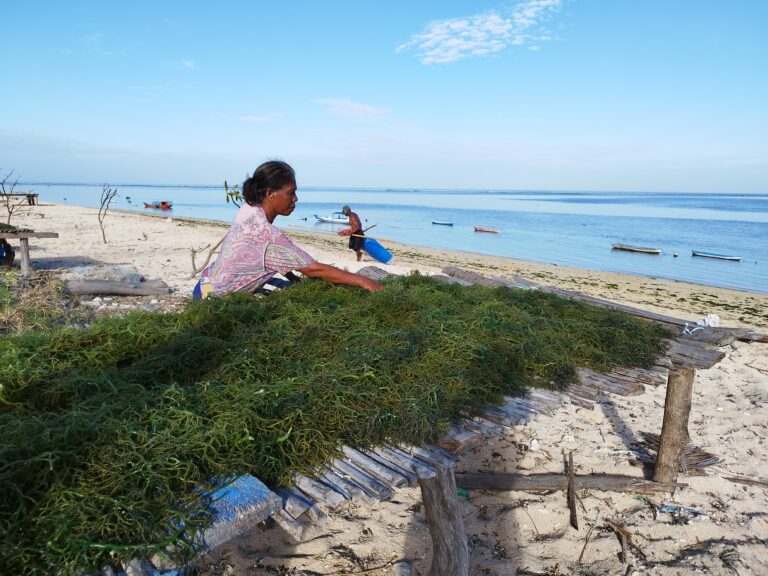
“Visioning on seaweed for humanity and creating job opportunities for the vulnerable coastal community, especially women in Eastern Indonesia”
It’s challenging to introduce seaweed farming to the vulnerable coastal communities living in remote areas. It’s unrelated to technical issues, but changing daily activities from fishing to farming is difficult.
Dr. Neish says it’s not easy to grow seaweed if there is no strong relationship with the local people to address the basic needs of the vulnerable coastal community. However, many are interested in growing seaweed if they can reap the economic benefits.
Seaweed will not grow in a day; therefore, you cannot harvest and sell in a day. Unlike fishing, where you can catch and sell for a profit in a day, seaweed farming takes weeks. But how long can vulnerable coastal communities last without profit, waiting to get money from cultivating seaweed? Who will give them loans or capital for farming seaweeds? Who will buy the seaweed in remote areas? These questions should be addressed before starting to grow seaweed in coastal communities.
Seaweed is what’s called a cash crop. It needs 45 days for growing, harvesting, drying, and selling. Most buyers will go to the main production areas to source dried seaweed through local collectors. Thankfully, seaweed’s demand has grown an average of 10% yearly over the past two years. The buyers can provide down payments to farmers and local collectors to secure their supply. It’s a good job opportunity for the coastal community.
Dr. Neish has been working with the local communities and living in remote areas to build strong relationships with the vulnerable coastal communities. He is passionate about developing and growing seaweed as an alternative livelihood for these communities, especially women.
The coastal communities should not be left behind and live under poverty lines. They should have good jobs and generate income from coastal natural resources such as fish, lobster, crab, abalone, and seaweed. Dr. Neish introduced seaweed to the coastal communities and transferred his expertise to the local people. He had worked with Haji Adam Omar and Saadah to develop seaweed in the Philippines and then moved to Malaysia and Indonesia.
He worked with Made Simbik in Bali and introduced seaweed to coastal communities in Nusa Penida. Bali was formally the main seaweed production area before the booming tourist industry. Most seaweed farmers had worked in hotels, villas, resorts, restaurants, and cafés in Nusa Penida.
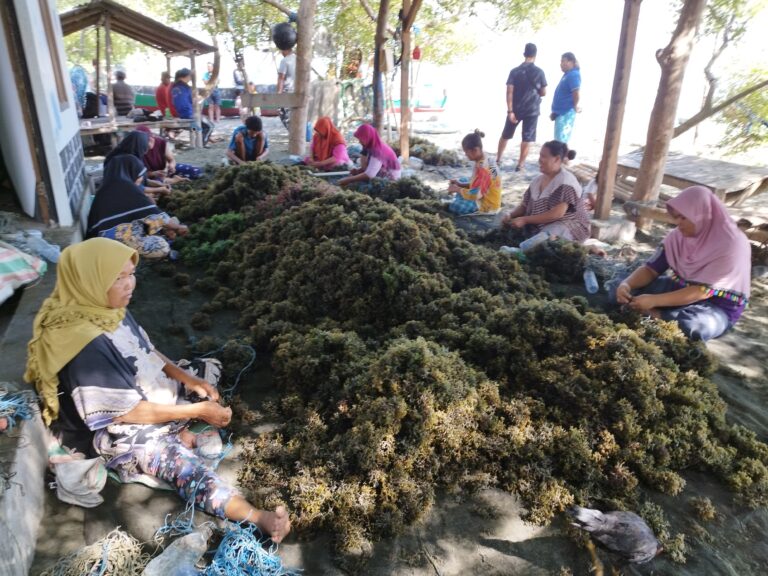
Seaweed production dropped. Many investors were more interested in building the tourist industry than in seaweed businesses. A thousand hotels, villas, resorts, restaurants, and café have been growing fast in the last two decades in Bali. The seaweed farm was depleted in Nusa Penida, Ceningan, and Lembongan; however, it recovered during the pandemic. Most people lost their jobs and returned to the sea to grow seaweed.
Many coastal communities are actively growing seaweed as an alternative livelihood for generating income. In the last two years, seaweed production increased significantly during the pandemic in Bali. They returned to the sea and cultivated seaweed with small working capital for buying nylon lines and seedlings.
Seaweed farming is a family or mom-and-pop business. The family unit–husband, wife, and children–works together with support from their extended family members. They can prepare the input materials and tie seaweed in their home; working from their home creates jobs for their neighbors, allowing them to tie long lines and, in turn, grow more seaweed.
Vulnerable coastal communities, especially women, have an opportunity to work in the seaweed sector. It’s not only tying the seaweed; they also have an option for access and control of coastal resources, such as seaweed farm management and making value-added healthy food and drinks from seaweed.
Women have an essential role in developing the seaweed sector in Indonesia. They prepare most input materials, tie seaweed, harvest seaweed, post-harvest handling, and trade raw dried seaweeds. They also visit the farm to install and maintain the seaweed during the low tide.
Women managed the off-bottom method Kappapycus alvarezii (cottonii) Kappaphycus striatus (sacol) and Euchema denticulatum (spinosum) seaweed farm or Gracilaria changii, Gracilaria gigas in the brackish water pond. The women had difficulties if the seaweed farm cultivated long lines method and located in the deep water with the strong wave. This role had taken by the men or their husbands who worked hand in hand with her.

Indonesia has become the second-largest seaweed producer after China and the biggest producer of tropical seaweed in the world. Women have a significant role in developing seaweed aquaculture in Indonesia, especially in the primary production areas in South Sulawesi, Bali, and Nusa Tenggara Timur (NTT).
It’s fascinating to look at the women’s role in developing seaweed aquaculture in Indonesia. Their role is not only in the downstream or farming activities. The women also actively participate in seaweed trading and processing to create business and job opportunities, especially for the vulnerable coastal communities.
The patriarchy of the coastal community had limited the women from taking the primary role in seaweed aquaculture. It happened in the coastal community of South Sulawesi, Bali, and Nusa Tenggara Timur.
Formerly, most women only prepare input materials, securing seaweed in nylon lines and drying seaweeds. It’s due to the supremacy of the father or male who has absolute authority over the family group.
Initially, women did not have a role in managing seaweed farms, limited access, and controlled coastal natural resources. Most of the seaweed trade is dominated by men. It’s a challenge for women to have their own seaweed farms or have business opportunities in the industry.
The value of seaweed, especially cottonii and sacol, has increased due to the high demand for processed seaweed or carrageenan as an ingredient for food, feed, cosmetics, and pharmaceuticals. It’s a positive impact on the coastal communities which has economic, social, and environmental value. Therefore, International Development Agency, Non-Government Organizations, and Multilateral Organizations (IFC, World Bank, FAO, ILO, UNIDO, GTZ) are interested in developing seaweed projects in Eastern Indonesia.
The projects would support the vulnerable coastal communities in building capacity for seaweed farmers, traders, and processors. The projects aim to address gender equality and support women attempting to access and control coastal natural resources, enhancing their lives as leaders in the industry.
With support from the projects and collaboration with multi-stakeholders, Indonesia has become the biggest tropical seaweed producer since 2008, making Indonesia the second largest after China. According to Queensland University research, the Indonesia seaweed sector creates income for over a million coastal people, especially in Eastern Indonesia.
Women’s role in the seaweed sector has changed over the last two decades. Restoring Coastal Livelihood, the OXFAM project, facilitated the vulnerable women to access and control coastal natural resources and supported the women’s economic group to have an alternative livelihood. Women could manage their own farms and trade dried seaweed to the market. They will raise their voices for equality in seaweed business opportunity and fair trading
UNIDO SmartFish project also provide support to strengthen the trade capacity of the seaweed sector. The Socialization and Training of Standard Operating Procedure (SOP) for Farming Seaweeds had delivered to 2,000 seaweed farmers in South Sulawesi, South East Sulawesi, East Java, and Central Java.
Implemented by partners Jaringan Sumber Daya (JaSuDa) and UNIDO in South Sulawesi, SmartFish finalized the SOP monitoring for Farming Kappaphycus spp, Eucheuma spp, and Gracilaria spp. In total, 399 farmers had adopted SOP in Bulukumba, 406 farmers in Janeponto, 353 farmers in Maros and 401 farmers in Pangkep.
Women’s role in the seaweed business is very important, especially in financial control and maintaining the input materials. Mama Yos had been growing seaweed when her husband worked as an informal construction laborer in Kupang, Nusa Tenggara Timur.
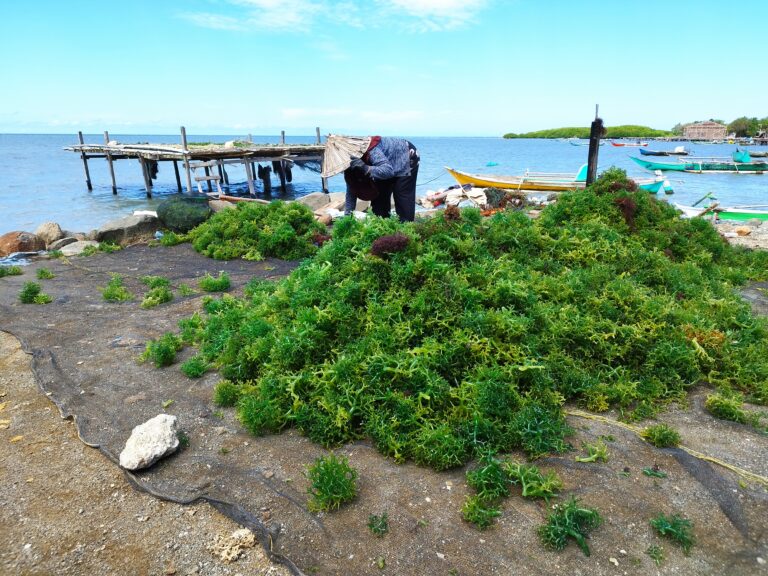
She managed her own farm and only requested her husband’s support when he lost his job due to the project closing down when the pandemic hit. They had been growing Cottonii with the off-bottom method. It’s not far from their house. They harvested some seaweed after 45 days and dried it on a wooden platform. The dried cotton farm gate price will be up to IDR 40,000 per kg in August 2022.
“I had difficulties during the Seroja cyclone hit on April 2021. My farm assets were devastated by cyclones, I lost nylon lines and seaweed biomass. I did not have capital and started seaweed farming from zero. We also had a problem with the governor’s regulation which banned the seaweed shipped out to site NTT, and the price dropped from IDR 40,000 to IDR 30,000 per kg.”
The seaweed farmers had many challenges such as epiphyte, ice–ice disease, grazer, flooding, and cyclone with strong winds or waves. It’s affected seaweed biomass loss and reduced the productivity and income of the farmers.
The seaweed farmers and vulnerable coastal communities should have access to finance, market, and technology. It will help them do seaweed business and increase production and sales to the market.
The seaweed farmers had adopted simple technology and Standard Operating Procedure (SOP) to increase the efficiency of seaweed farmers’ operations. The women had actively involved in the Socialization and Training SOP. They also monitored the farmers who had adopted the SOP in Bulukumba, Janeponto, Pangkep, and Maros.
Traditional trolleys or gerobak made by the farmer have been used to transfer the seedling from the farmer’s house to the beach before the farmers load it onto the small boat. The gerobak is made of wooden materials. It’s easy to find in the village.
The SOP for Farming Seaweeds had adopted by the farmers. They also have the equipment to monitor the farm’s water quality changes. Therefore, they could minimize the failure due to extreme salinity, pH, and temperature.
The vulnerable coastal communities, especially women, have their primary incomes from seaweed farming and business. They receive benefits from seaweed farming. It’s not only the economic benefit. They also have time to share stories of their life during tying seaweeds to improve their lives.